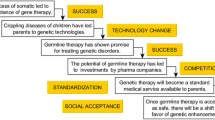Abstract
One of the major factors affecting contemporary academic debate about biotechnology in general, and genetic engineering in particular, is that virtually all participants approach the issues from the standpoint of consequentialist moral theory. Now consequentialism takes many forms, especially when it comes to the question of just what it is that rational agents should be seeking to maximise. We can, however, abstract from these variations and note that as far as biotechnology is concerned, all consequentialists frame the terms of the debate around the key question of what harms or benefits a given technique, practice or method is likely to bring about.
Access this chapter
Tax calculation will be finalised at checkout
Purchases are for personal use only
Preview
Unable to display preview. Download preview PDF.
Similar content being viewed by others
Notes
For a collection of papers defending this view of consequentialism, see D. S. Oderberg and J. A. Laing (eds.) (1997) Human Lives: Critical Essays on Consequentialist Bioethics (Basingstoke: Macmillan).
P. Singer and Deane Wells (1984) The Reproduction Revolution (Oxford: Oxford University Press), pp. 36–41.
For a recent critique, see C. J. Martin (2004) ‘The Fact/Value Distinction’, in D. S. Oderberg and T. Chappell (eds.), Human Values: New Essays on Ethics and Natural Law (Basingstoke: Palgrave Macmillan), pp. 52–69. See also Oderberg, Moral Theory, pp. 9–15.
M. J. Reiss and R. Straughan (1996) Improving Nature? The Science and Ethics of Genetic Engineering (Cambridge: Cambridge University Press), p. 63.
J. Cottingham (2004), ‘“Our Natural Guide …”: Conscience, “Nature”, and Moral Experience’, in Oderberg and Chappell (eds.), Human Values, pp. 11–31.
For more on this, see S. Uniacke (2004) ‘Harming and Wronging: The Importance of Normative Context’, in Oderberg and Laing (eds.), Human Lives, pp. 166–83.
For more on this problem, see Jacqueline A. Laing (2004) ‘Innocence and Consequentialism: Inconsistency, Equivocation and Contradiction in the Philosophy of Peter Singer’, in Oderberg and Chappell (eds.), Human Values, pp. 196–224, at pp. 209–12.
M. Häyry (1994) ‘Categorical Objections to Genetic Engineering — A Critique’, in A. Dyson and J. Harris (eds.), Ethics and Biotechnology (London: Routledge), pp. 202–15, at p. 202.
U. Wessels (1994) ‘Genetic Engineering and Ethics in Germany’, in Dyson and Harris (eds.), Ethics and Biotechnology, pp. 230–58.
See, for instance, J. Finnis (1980) Natural Law and Natural Rights (Oxford: Clarendon Press)
T. Chappell (1998) Understanding Human Goods (Edinburgh: Edinburgh University Press)
M. Murphy (2001) Natural Law and Practical Rationality (Cambridge: Cambridge University Press)
Alfonso-Gómez-Lobo (2002) Morality and the Human Goods (Washington, DC: Georgetown University Press) see also Oderberg, Moral Theory, ch. 2, and (2004) ‘The Structure and Content of the Good’, in Oderberg and Chappell (eds.), Human Values, pp. 127–65.
See, for example, Joanna Rose (1999) ‘The Response of an Adult Donor Insemination Offspring to the Article “The Psychology of Assisted Reproduction — or Psychology Assisting its Reproduction?”’, Australian Psychologist, 34, p. 220
Christine Whipp (1998) ‘The Legacy of Deceit: a Donor Offspring’s Perspective on Secrecy in Donor Assisted Conception’, in Eric Blyth, Marilyn Crawshaw and Jennifer Speirs (eds.), Truth and the Child 10 Years On: Information Exchange in Donor Assisted Conception (Birmingham: British Association of Social Workers). For further information, see the notes in Laing and Oderberg, ‘Artificial Reproduction’.
M. Warnock (2003) ‘What is Natural? And Should We Care?’, Philosophy, 78, pp. 445–59, at pp. 457–8. Quotations are from these pages.
For example, Ole Schou is chief of Danish sperm bank, Cryos International Sperm Bank Ltd: ‘Cyros dominates the Scandinavian market from its headquarters in Aarhus, Denmark. In the early 1990s, the country began looking abroad for ways to expand its business and now exports to 25 countries, including Australia, Eastern Europe, and the US. It market three grades of sperm, including “Extra” grade, which contains twice as many sperm as the standard grade and exhibits the highest levels of motility, a measure of sperm’s ability to reach its target’ (Pascal Zachary, Wall Street Journal, 6 January 2000).
For emerging evidence of the harm caused by IVF, see M. Hansen, J. J. Kurinczuk et al. (2002) ‘The Risk of Major Birth Defects after Intracytoplasmic Sperm Injection and In Vitro Fertilization’, New England Journal of Medicine, 346, pp. 725–30. This study found that IVF offspring have twice as high a risk of a major (e.g. chromosomal or musculoskeletal) birth defect as naturally conceived infants.
See Oderberg, Moral Theory, ch. 3; T. Chappell (2002) ‘Two Distinctions that Do Make a Difference: The Action/Omission Distinction and the Principle of Double Effect’, Philosophy, 77, pp. 211–34
M. Murphy (2004) ‘Intention, Foresight, and Success’, in Oderberg and Chappell (eds.), Human Values, pp. 252–68.
S. R. L. Clark (2004) ‘Natural Integrity and Biotechnology’, in Oderberg and Chappell (eds.), Human Values, pp. 58–76, at p. 67.
See further D. S. Oderberg (2000) Applied Ethics (Oxford: Blackwell), ch. 3.
J. Harris (1992) Wonderwoman and Superman: The Ethics of Human Biotechnology (Oxford: Oxford University Press), p. 160.
In September 1997, the World Health Organisation’s Regional Committee for the Western Pacific issued a report claiming that ‘more than 50 million women were estimated to be “missing” in China because of the institutionalized killing and neglect of girls due to Beijing’s population control program that limits parents to one child’ (see Joseph Farah (1997) ‘Cover-up of China’s Gendercide’, Western Journalism Center/Free Republic, 29 September); www/freerepublican.com/forum/98896.htm Accessed 23 May 2005. A similar story is true for India.
Editor information
Editors and Affiliations
Copyright information
© 2005 David S. Oderberg
About this chapter
Cite this chapter
Oderberg, D.S. (2005). Towards a Natural Law Critique of Genetic Engineering. In: Athanassoulis, N. (eds) Philosophical Reflections on Medical Ethics. Palgrave Macmillan, London. https://doi.org/10.1057/9780230273931_6
Download citation
DOI: https://doi.org/10.1057/9780230273931_6
Publisher Name: Palgrave Macmillan, London
Print ISBN: 978-0-230-24704-8
Online ISBN: 978-0-230-27393-1
eBook Packages: Palgrave Religion & Philosophy CollectionPhilosophy and Religion (R0)




